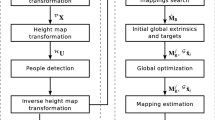Abstract
A calibrated camera is essential for computer vision systems: the prime reason being that such a camera acts as an angle measuring device. Once the camera is calibrated, applications like three-dimensional reconstruction or metrology or other applications requiring real world information from the video sequences can be envisioned. Motivated by this, we address the problem of calibrating multiple cameras, with an overlapping field of view observing pedestrians in a scene walking on an uneven terrain. This problem of calibration on an uneven terrain has so far not been addressed in the vision community. We automatically estimate vertical and horizontal vanishing points by observing pedestrians in each camera and use the corresponding vanishing points to estimate the infinite homography existing between the different cameras. This homography provides constraints on intrinsic (or interior) camera parameters while also enabling us to estimate the extrinsic (or exterior) camera parameters. We test the proposed method on real as well as synthetic data, in addition to motion capture dataset and compare our results with the state of the art.
Similar content being viewed by others
References
Criminisi A., Reid I., Zisserman A.: Single view metrology. Int. J. Comput. Vis. 40(2), 123–148 (2000)
Cao, X., Foroosh, H.: Metrology from vertical objects. In: Proceedings of BMVC (2004)
Tsai R.Y.: A versatile camera calibration technique for high-accuracy 3D machine vision metrology using off-the-shelf tv cameras and lenses. IEEE J. Robo. Autom. 3(4), 323–344 (1987)
Zhang Z.: A flexible new technique for camera calibration. IEEE Trans. Pattern Anal. Mach. Intell. 22(11), 1330–1334 (2000)
Zhang Z.: Camera calibration with one-dimensional objects. IEEE Trans. Pattern Anal. Mach. Intell. 26(7), 892–899 (2004)
Sturm, P.: Critical motion sequences for the self-calibration of cameras and stereo systems with variable focal length. In: British Machine Vision Conference, Nottingham, England, pp. 63–72 (1999)
Faugeras, O., Luong, T., Maybank, S.: Camera self-calibration: theory and experiments. In: Proceedings of ECCV, pp. 321–334 (1992)
Hartley, R.I.: Self-calibration from multiple views with a rotating camera. In: Proceedings of ECCV, pp. 471–478 (1994)
Triggs, B.: Autocalibration from planar scenes. In: Proceedings of ECCV, pp. 89–105 (1998)
Hartley, R.I., Zisserman, A.: Multiple view geometry in computer vision, 2nd edn. Cambridge University Press, ISBN: 0521540518, (2004)
Caprile B., Torre V.: Using vanishing points for camera calibration. Int. J. Comput. Vis. 4(2), 127–140 (1990)
Cipolla, R., Drummond, T., Robertson, D.: Camera calibration from vanishing points in images of architectural scenes. In: Proceedings of BMVC, pp. 382–391 (1999)
Liebowitz, D., Zisserman, A.: Combining scene and auto-calibration constraints. In: Proceedings of IEEE ICCV, pp. 293–300 (1999)
Cao, X., Foroosh, H.: Simple calibration without metric information using an isosceles trapezoid. In: Proceedings of ICPR, pp. 104–107 (2004)
Lv, F., Zhao, T., Nevatia, R.: Self-calibration of a camera from video of a walking human. In: IEEE International Conference of Pattern Recognition (2002)
Krahnstoever, N., Mendonca, P.R.S.: Bayesian autocalibration for surveillance. In: Tenth IEEE International Conference on Computer Vision (2005)
Krahnstoever, N., Mendonca, P.R.S.: Autocalibration from tracks of walking people. In: British Machine Vision Conference (2006)
Junejo, I., Foroosh, H.: Trajectory rectification and path modeling for video surveillance. In: Eleventh IEEE International Conference on Computer Vision (ICCV) (2007)
Junejo I., Foroosh H.: Euclidean path modeling for video surveillance. Elsevier J. Image Vis. Comput. 26(4), 512–528 (2008)
De Agapito L., Hayman E., Reid I.: Self-calibration of rotating and zooming cameras. Int. J. Comput. Vis. 45(2), 107–127 (2001)
Pollefeys M., Koch R., Gool L.V.: Self-calibration and metric reconstruction in spite of varying and unknown internal camera parameters. Int. J. Comput. Vis. 32(1), 7–25 (1999)
Press W., Flannery B., Teukolsky S., Vetterling W.: Numerical Recipes in C. Cambridge University Press, London (1988)
Javed, O., Shah, M.: Tracking and object classification for automated surveillance. In: The Seventh European Conference on Computer Vision (ECCV) (2002)
Hartley R.I.: In defense of the eight-point algorithm. IEEE Trans. Pattern Anal. Mach. Intell. 19(6), 580–593 (1997)
Lv F., Zhao T., Nevatia R.: Camera calibration from video of a walking human. IEEE Trans. Pattern Anal. Mach. Intel. 28(9), 1513–1518 (2006)
Video understanding evaluation project: http://www-sop.inria.fr/orion/ETISEO/
Author information
Authors and Affiliations
Corresponding author
Rights and permissions
About this article
Cite this article
Junejo, I.N. Using pedestrians walking on uneven terrains for camera calibration. Machine Vision and Applications 22, 137–144 (2011). https://doi.org/10.1007/s00138-009-0210-2
Received:
Revised:
Accepted:
Published:
Issue Date:
DOI: https://doi.org/10.1007/s00138-009-0210-2




